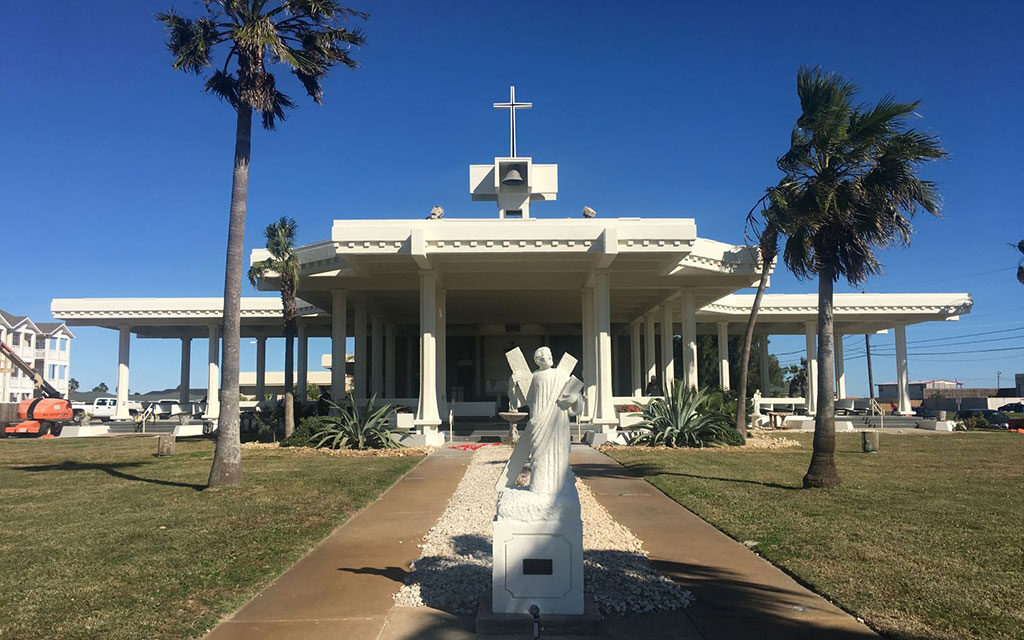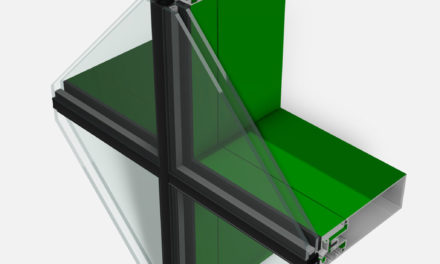St. Andrew by the Sea Catholic Church in North Padre Island, Texas is an open-air, concrete pavilion designed in 1973 to resemble the ancient Greek temples that once dotted the Mediterranean shoreline almost 2,000 years ago. One of the only open-air parishes in the world to celebrate mass year-round, the 6,100-square-foot seaside church was deteriorating from decades of exposure to one of the most corrosive environments in the U.S.
The Diocese of Corpus Christi contacted the concrete restoration experts at Western Specialty Contractors – San Antonio, TX Branch to restore the church to its original beauty and integrity, and to protect and extend its service life. The church had numerous chips, cracks and spalls on the concrete pews, under the roof structure and around repair patches. Every structural beam and column within the pavilion also needed repair, as well as a wooden cross and bell tower at the top of the church. In total, approx. 2,300 square feet of repairs were needed.
Safety, Access and Site Preparation
Safety was paramount at the site, and considerations were made at every step to ensure the health and safety of all those involved on the project. The pavilion remained closed during the entire construction process and fencing surrounded the perimeter to protect the work zone and limit entry. Custom scaffolding was erected with an elevated “dance floor” platform to provide access to the entire workspace while protecting the floors and pews below. This set up enabled workers to ergonomically perform repair duties to the underside of the roof structure. Proper PPE was required while on site and measures were taken to adhere to OSHA’s Crystalline Silica Standard which went into effect just before the construction project began. The structure was protected from the outside elements allowing work to continue regardless of weather conditions. Health and safety were considered in the selection of the materials, placement methods and equipment used. Low-dust repair mortar was selected, dust collection systems with HEPA filters were employed and the use of monopod jackhammers contributed to the comfort and productivity of the crew. All deteriorated/delaminated concrete was identified and marked using a sounding hammer, then extended a minimum of six inches and configured in square or rectangular patterns.
Concrete Spall Repairs
In cases where the repair area was equal to or less than an inch in thickness, BASF MasterEmaco N 425 vertical and overhead repair mortar was applied by hand. All repair areas were first marked, chipped back to sound concrete with a chipping hammer, and finally, saw cut to square. Additionally, any exposed rebar was ground down to “clean” and if the rebar did not meet ICRI standards it was removed and replaced. BASF Master Protect P 8100 AP, a one-component epoxy primer for rebar, was applied to the steel when exposed to prevent corrosion. Proper bonding of the repair mortar to the existing concrete was ensured by achieving a CSP of 5-6 in the repair area.
Form and Pour Repairs
As more of the original coating was removed, numerous deeper spalls were exposed. In these cases, both partial and full-depth form and pour methods were utilized. To match the existing decorative concrete, custom forms were created, paying special attention to clean carpentry. Surface preparations were completed in accordance with ICRI Guidelines and careful attention was paid to the proper cleaning, preparation and quality of the existing rebar. When corrosion was present, the concrete was completely undercut from around the corroded reinforcement to ensure long-term performance and primer was applied to the rebar. In many cases, the reinforcing steel was placed too shallow (less than 0.75 inches between exposed steel and surrounding concrete), and additional sound concrete had to be removed and the rebar replaced in compliance with ACI standards. BASF MasterEmaco S440, a low-dust, pre-extended, pourable and pumpable, self-consolidating repair mortar, was selected for this repair method.
Crack Repairs and Existing Concrete Repair Patches
All non-moving cracks were treated with the same methods as the spall repairs, and existing concrete repair patches were removed and retreated properly with either the hand-applied or form and pour method. This method of treating the cracks and redoing the existing patches ensured the lines would not show through, and to mitigate any further corrosion caused by exposed rebar.
Bell Tower and Cross
Cracks were observed along the exterior faces of the bell tower on the base, walls and edges. The wood frame was also rotted and corrosion was present along the steel framing at the base. Ultimately, the entire bell tower and cross had to be shored up and rebuilt while kept in place. The Garland Company, Inc. worked with Western to complete the repairs, replacing all the wood wrapping around the cross’ aluminum frame, and applying the texture and coating to match the existing structure.
Texture and Façade Coating
Because the pavilion had been previously coated with a thick, textured elastomeric coating, and subsequently removed in the marked areas for repair, a challenge then arose to match the existing texture and hide the transitions. After multiple, unsuccessful attempts to match the existing surface texture with acrylic coatings, the unique solution to spray-apply the MasterEmaco N 425 with a hopper gun created the seamless transition from existing surface to repair surface. When a final all-over coating of an elastomeric waterproof coating was applied (BASF MasterProtect EL 750), the structure was additionally protected and appeared flawless.
St. Andrew by the Sea Catholic Church has been completely restored to its original glory. Expertise, artistry and creativity were applied daily during the rehabilitation which resulted in a flawless, gleaming structure the ancient Greeks would be proud of. Western’s full-time crew of six finished the project within nine months.
About Western Specialty Contractors
Family-owned and operated for more than 100 years, Western Specialty Contractors is the nation’s largest specialty contractor in masonry and concrete restoration, waterproofing and specialty roofing. Western offers a nationwide network of expertise that building owners, engineers, architects and property managers can count on to develop cost-effective, corrective measures that can add years of useful life to a variety of structures including: industrial, commercial, healthcare, historic, educational and government buildings, parking structures and sports stadiums. Western is headquartered in St. Louis, MO with 30 branch offices nationwide and employs more than 1,200 salaried and hourly professionals who offer the best, time-tested techniques and innovative technology. For more information about Western Specialty Contractors, visit www.westernspecialtycontractors.com.




